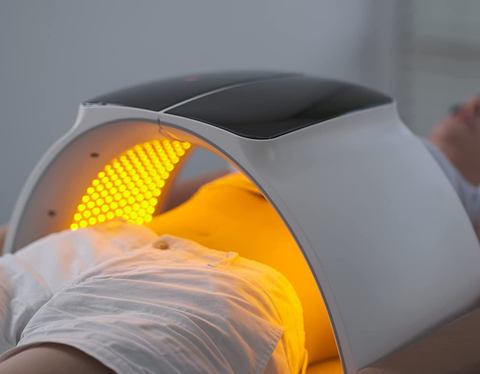Nowadays, both red light and photon LED light therapy devices are hot topics among healing and rejuvenation enthusiasts. Due to a lack of knowledge about these two therapies, many people cannot make an informed decision. Today, we will explore the distinctions between red light therapy and photon LED light, their unique benefits, and their practical incorporation into daily routines.
Introduction
The principle of the red light therapy device is to use the red or near-infrared light wavelength of 660-850nm to irradiate the body to stimulate mitochondria and promote wellness. Photon LED light therapy contains a range of wavelengths: red, blue, green, yellow, orange, violet, and near-infrared. Both therapies deliver photochemical and therapeutic effects in the body. After NASA's potential studies of red light therapy on wound healing and regeneration, it has been continuously gaining popularity in medical fields and the skin care industry. Photon LED treatment emerged as a targeted treatment after the innovation in LED technology. It is used especially for cosmetic purposes such as aging, acne, sunburns, etc.
Photon LED Light Therapy and Red Light Therapy Advantages
Photon LED light therapy provides several benefits, depending on wavelengths.
|
Wavelength |
Affect |
|
Violet |
308 nm wavelength effect is weaker than red light and can repair skin and mucous membrane ulcers and acne. |
|
Blue |
415 nm wavelength has antibacterial effects, inhibits allergies, eliminates tissue congestion, relaxes nerves, and relieves pain. |
|
Green |
560 nm wavelength calms and soothes sensitive skin |
|
Yellow |
590 nm enhances lymphatic flow and prevents pigmentation. |
|
Orange |
610 nm promotes blood circulation and accelerates metabolism. |
|
Red |
635 nm is the longest wavelength, has strong penetration, is anti-inflammatory and analgesic, and accelerates wound healing. |

Red light therapy has diverse and impactful advantages on health and wellness, such as improving.
- Cell metabolism and regeneration.
- Blood circulation.
- Function of the immune system.
- Healing of wounds and ulcers.
- Anti-aging.
- Pain relief.
- Quality of sleep.
Comparison: Red Light Therapy vs. Photon LED Light Therapy
|
Criteria |
Photon LED Light Therapy |
Red Light Therapy |
|
Mechanism of Action |
Multi-colour lights (red, blue, green, yellow, orange, violet, near-infrared) |
Red or near-infrared lights |
|
Skin Conditions |
Acne, fine lines, hyperpigmentation |
Anti-aging, skin texture, tone, sunburn, scarring |
|
Side Effects |
Minimal to none |
Minimal to none |
|
Treatment Time |
10-20 mins |
10-30 mins |
|
At-home Cost of the device |
$50 - $200 |
$50 - $300 |
Using Red Light Therapy or Photon LED Light Therapy
Choosing a light therapy device is tricky; get thorough information to ensure its safety and effectiveness. Depending on personal choices, both red light therapy and photon-led light therapy can be added to the routine.
Goal of treatment
A clear understanding of health conditions can help you choose the best therapy. Photon LED therapy is suitable for treating multiple skin-related issues, such as hyperpigmentation, acne, and allergies. Red light therapy is more potent for wound healing, improving skin tone and texture, pain relief, etc.
Usage Convenience
Red light therapy can be applied with portable devices at home or professional treatment clinics. In contrast, photon LED therapy needs multi-color devices that offer versatility but may require more effort and time for treatment.
Seek Professional Guidance
Dermatologists and healthcare specialists can assist you in therapy selection if you are unsure about the skin condition.

Manual Guide
Personal Safety
It is recommended to use the red or photon LED light therapy device at least four times a week, with each session lasting no more than 60 minutes. Wear special goggles while using therapy; the blue light wavelength is close to ultraviolet rays, and direct exposure can easily damage the retina. Red light wavelengths do not directly cause harm to the eyes but may cause discomfort upon prolonged exposure.
Non-invasive Therapy
These devices are a safe, non-invasive, scientifically-backed treatment that uses low-energy red light to irradiate the skin without the use of medication or surgery, making it suitable for people of all ages.
Cost of buying
RLT devices range in price from $50 - $300; at-home usage devices are more affordable in the long run. A photon LED therapy typically costs around $200, while a face mask option costs around $500 or more. The equipment should meet professional safety standards.
Conclusion
Red light therapy and photon-led light therapy act on the skin with the help of specific wavelengths of light, improve skin by increasing the activity of cells, and promote collagen production. They are non-invasive and non-burning, unlike UV light therapy, and the patient feels comfortable during the treatment. No special care is needed after applying red light and photon-led light therapy. Therapy device operations are user-friendly, simple, and fast, which allows us to enjoy more benefits!
References and Citations
[1] Glass G. E. (2021). Photobiomodulation: The Clinical Applications of Low-Level Light Therapy. Journal of Aesthetic Surgery, 41(6), 723–738. https://doi.org/10.1093/asj/sjab025
[2] Rocha Mota, L., Motta, L. J., Duarte, I. D. S., Horliana, A. C. R. T., Silva, D. F. T. D., & Pavani, C. (2018). Efficacy of phototherapy to treat face aging when using a red versus an amber LED; protocol for a randomized controlled trial. BMJ open, 8(5), e021419. https://doi.org/10.1136/bmjopen-2017-021419
[3] Hamblin M. R. (2017). Mechanisms and applications of the anti-inflammatory effects of photobiomodulation.AIMSbiophysics, 4(3),337–361. https://doi.org/10.3934/biophy.2017.3.337
[4] Rohringer, S., Holnthoner, W., Chaudary, S., Slezak, P., Priglinger, E., Strassl, M., Pill, K., Mühleder, S., Redll, H., & Dungel, P. (2017). The impact of wavelengths of light therapy on ECs. Scientific reports, 7(1), 10700. https://doi.org/10.1038/s41598-017-11061-y
[5] Kim, S. K., You, H. R., Kim, S. H., Yun, S. J., Lee, S. C., & Lee, J. B. (2016). Skin photorejuvenation effects of light-emitting diodes (LEDs): a comparative study of yellow and red LEDs in vitro and in vivo. Clinical and experimental dermatology, 41(7), 798–805. https://doi.org/10.1111/ced.12902














 Small
Small

 Moderate
Moderate

 Moderate
Moderate

 Moderate
Moderate

 Full
Full



